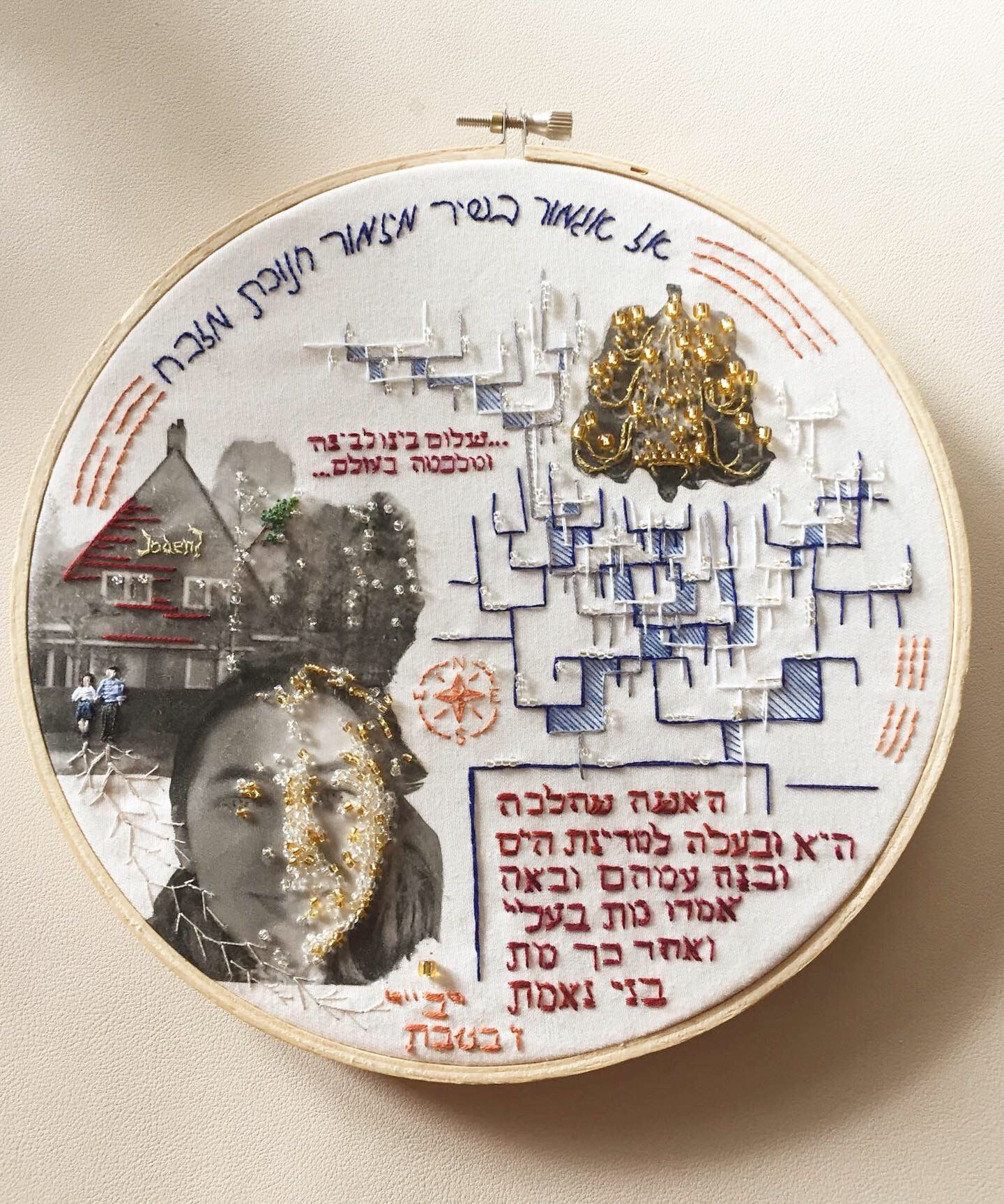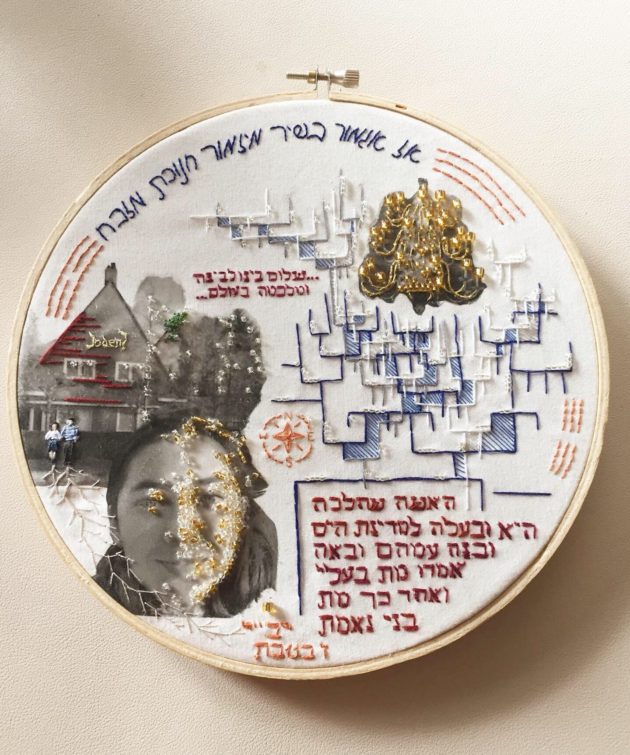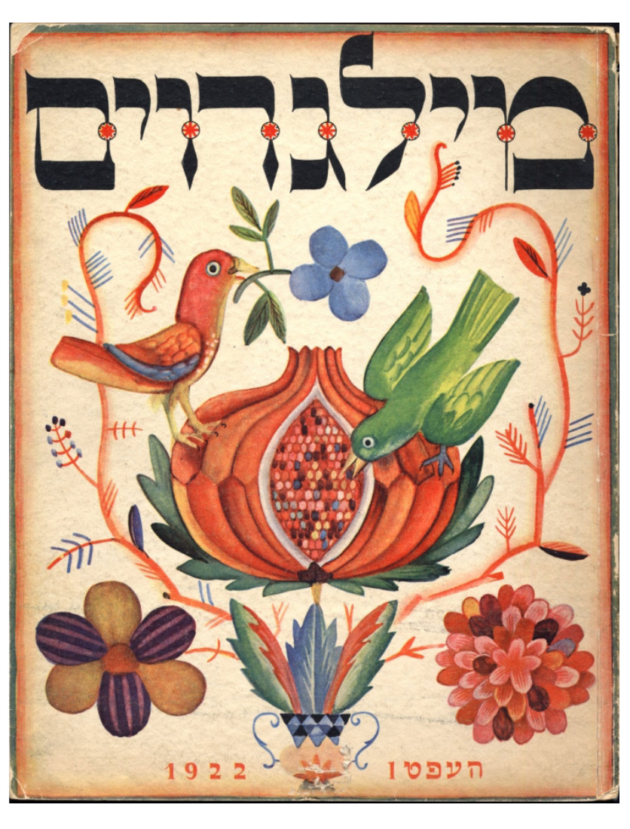
Embroidering Her Past
Maxine Lee Ewaschuk is dancer and fibre artist based in Toronto, Canada. She shares her original embroidered artwork @exp.threads, which she describes as “stitching stories with thread and words.” Ewaschuk’s work draws on a wide range of influences from modernist art to Korean folk culture to the Yiddish cultural milieu to Bernie Sanders and his mittens! Inspired by early 20th-Century Expressionist painters, she interprets their dynamic brushwork into lively stitches and bold embroidery.
She was commissioned by PRISM––a convening on March 16 for Jews of Color who are artists and culture-makers––to create a new work to promote this online event. As part of Lilith’s ongoing collaboration with the team of creatives behind PRISM, Lilith invited Maxine Lee Ewaschuk to write about what inspires her embroidered pieces and, in particular, the unique composition she made for PRISM.
A fibre artist since childhood, embroidery became my primary focus only recently. I was taught the basics of cross-stitch by my mother, but I am otherwise self-taught. I found that embroidery, rather than cross-stitch or other forms of fibre art allowed me the space I wanted to experiment and let my ideas develop during the process of making. The iconography in my work reflects the lenses through which I see the world and the world sees me. My embroidered images frequently reference art history as well as personal and familial history. Often my Judaism and my Korean heritage come to the fore.

Maxine’s work with motifs from Korean and Yiddish folk cultures
For instance, one piece features a printed image of a mask used in Korean ritual dances, a Yiddish phrase warding off the evil eye, and a pair of hands in a position evoking the ballet “Giselle.” While each is taken from a different cultural context, all share origins in folk beliefs and practices relating to hostile spirits. Another multimedia piece combining embroidery, beading and photos, is informed by my relationship to my step-grandfather z”l (“May his memory be a blessing”), whose Dutch hometown I visited at the end of 2019. In it is a photo of me in front of his childhood home, with his parents stitched in as they were in the picture I used to identify the house. Clear and gold beads mimic the candlelight from the chandeliers in the Amsterdam Portugese Synagogue, which I visited during the same trip. The text I brought in is from Mishnah Yevamot, which I was learning in his memory. While the tractate, which focuses on mandated marriages and the status of minors, is no longer practically relevant, the complex family structures that are described in it reminded me a bit of my own.

Maxine’s work inspired by her relationship with her step-grandfather.
When I was asked to create a new piece leading up to the launch of PRISM, an initiative by and for Jewish artists of color, my first instinct was to look for resonances in Jewish history––perhaps in the work of a specific artist or movement. Whatever reference I would end up using wasn’t going to be obvious, since PRISM doesn’t have a clear precedent. While Jews of Color have been making art for as long as there have been Jews, there haven’t been many events or spaces dedicated to JOC artistic community and creation.

Cover of Milgroym, 1922. Image from Penn Libraries.
Through my research, I found some parallels for PRISM’s goals of developing diverse, forward-looking Jewish art in Milgroym and Rimon, a pair of Jewish art journals in Yiddish and Hebrew, first published in 1922. Ninety-nine years ago, these publications had an international readership and cast of contributors who were connected by an appreciation for the history and future of Jewish art. Fortunately, Milgroym/Rimon (“pomegranate” in Yiddish and in Hebrew) offered not only a model in spirit, but also rich and distinctive imagery to draw from.

Piece created for PRISM: A Convening for Jewish Artists of Colour.
For the PRISM project, I combined embroidery and gouache painting to create my own interpretation of the original Milgroym cover image. Unlike the source image, my birds have the black, white, and dark teal feathers characteristic of magpies, which are common in minhwa, a style of Korean folk painting originating in the 17th Century. In the top right corner, I added a stylized sun and clouds, typical of Korean paintings, to make this artistic consonance between Yiddish and Korean visual language clearer.
The pomegranate is ubiquitous in Jewish visual culture. Often representing fertility, its signification can also extend to fecundity and multiplicity, like the varied Jewish identities that will be represented at PRISM. Two birds appear here––partners perhaps. One alludes to the biblical dove with the olive branch, and the other samples the pomegranate seeds––the multicolored gems that make up Jewish art, especially the work that we hope will come to fruition as a result of this first PRISM convening.
The ethnic and religious identities that my ancestors and I have inhabited vary, which keeps me asking the question of who ‘my people’ really are
One of my biggest hopes is to develop a kind of contemporary folk art that necessarily resists essentialism. Today, many artists who are members of various diasporas and marginalized cultures are incorporating ancestral forms as part of the broader movement for decolonization. While I, like most artists, hope to make work that leads somewhere new, I feel inevitably drawn back to the past and toward my people’s histories. The ethnic and religious identities that my ancestors and I have inhabited vary, which keeps me asking the question of who ‘my people’ really are. This is an experience common to many Jews of Color and people who live where communal and identity-based boundaries blur. This questioning has sometimes felt like a curse, leaving me with the feeling that I’m not quite at home in any one space. However, in my artwork and other cases, I have come to see it as a blessing.
My Judaism combined with my mixed Korean heritage allows me to shift perspectives and to imagine myself and the world with both flexibility and groundedness––something I wish for everyone, regardless of background. I hope to touch on a wide breadth of themes and ideas in my artwork, and sometimes the particularity of my identity allows me to do that. In my piece for PRISM and in my work in general, I attend to multiple facets of my traditions. In doing so, I create art that is connected to the past, my present and an aspirational future.
PRISM is an online gathering for creatives and culture makers by Jews of Colour for Jews of Colour. This convening for artists and arts professionals will be held Tuesday, March 16, 2021 (5 PM PST; 8 PM EST) At PRISM, Maxine Lee Ewaschuk will facilitate a breakout room with fellow dancer and PRISM core team member, Adam W. McKinney. This is a free event but advanced registration is required. For additional information including commonly asked questions and to register go to http://fentster.org/events



